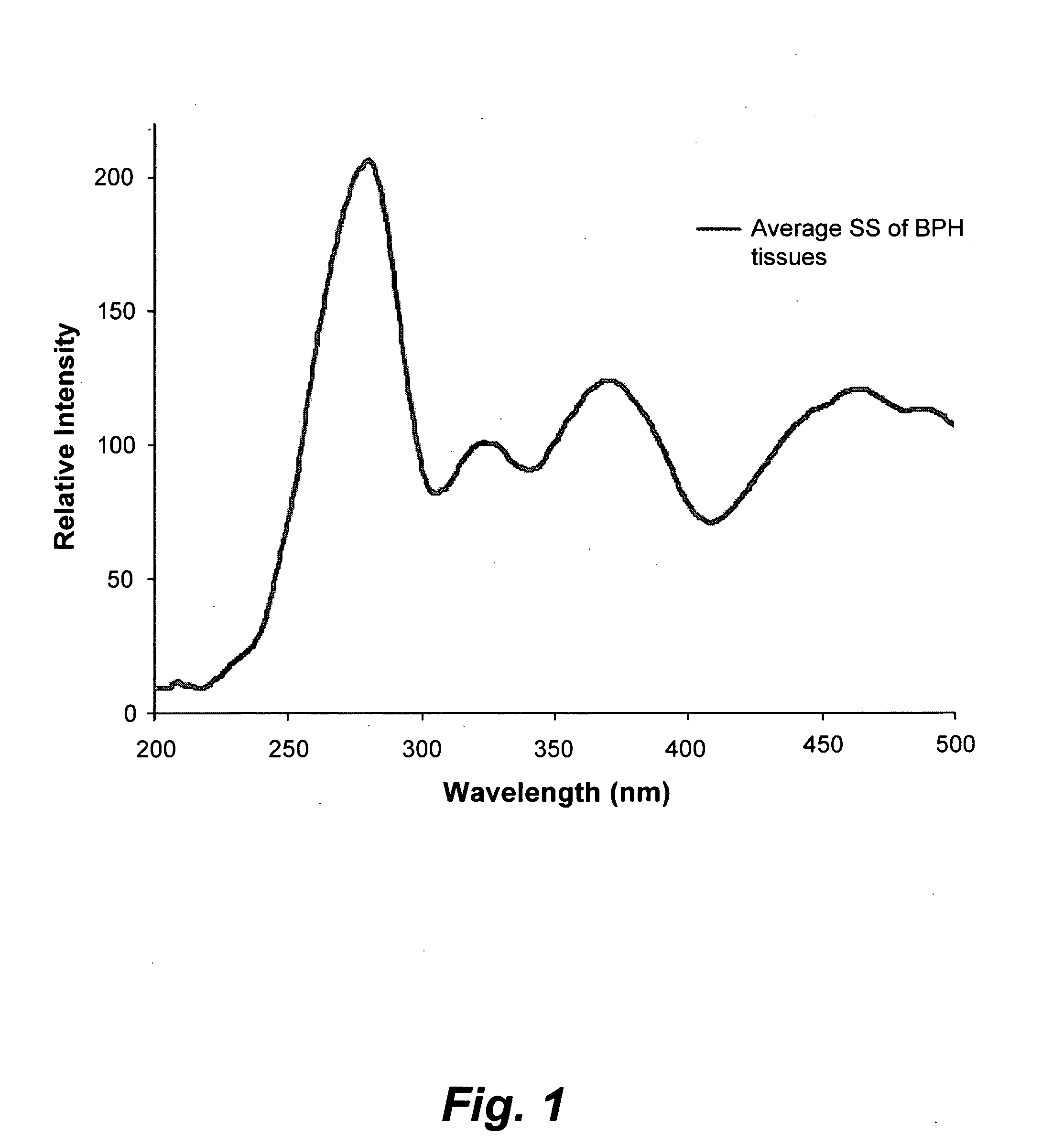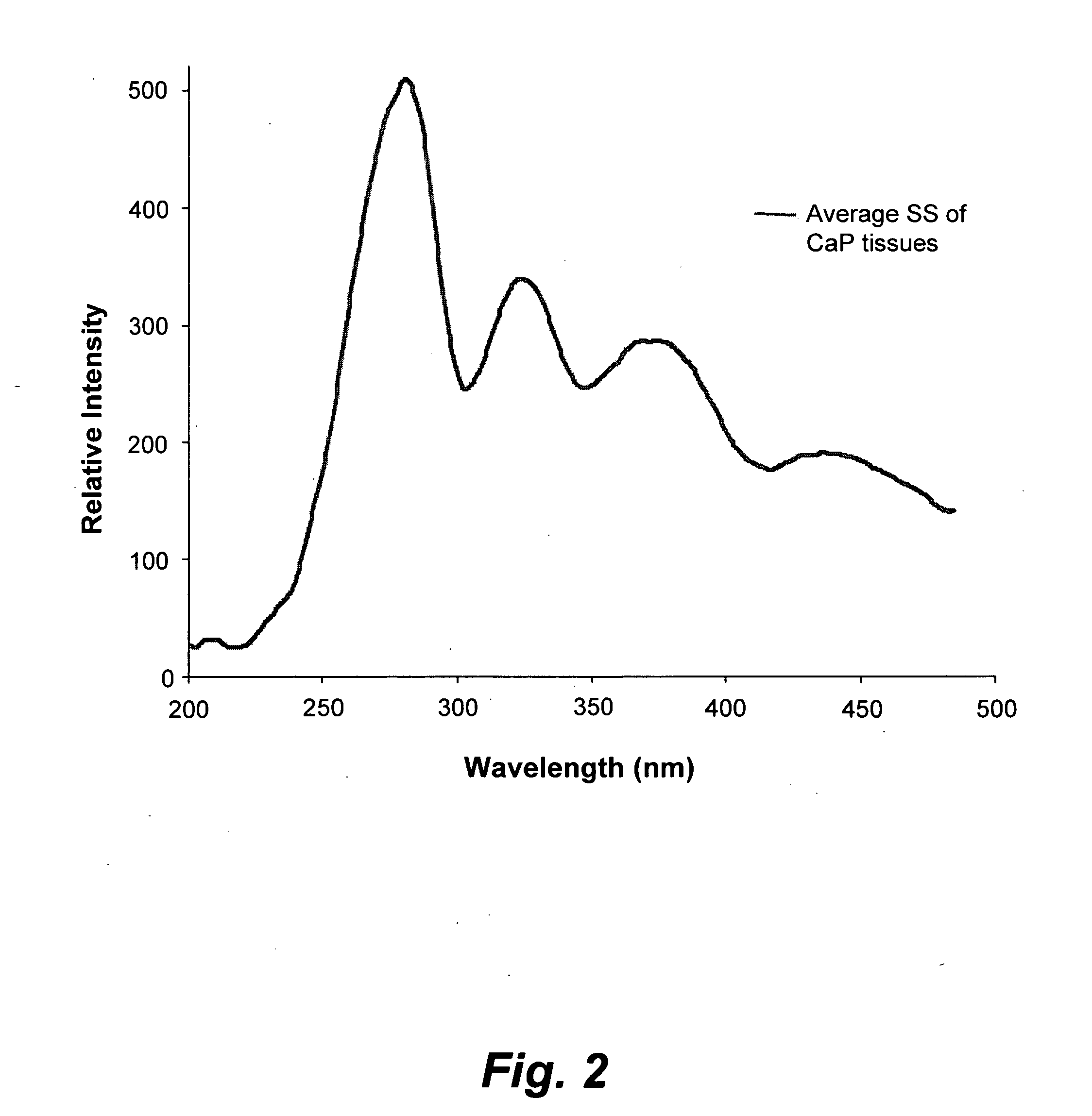Method for discriminating between benign and malignant prostate tumors
a prostate cancer and tumor technology, applied in the field of cancer diagnosis and tumor discrimination, can solve the problems of difficult diagnosis, difficult diagnosis, and difficult diagnosis, and achieve the effects of reducing the risk of cancer, and improving the accuracy of diagnosis and treatmen
- Summary
- Abstract
- Description
- Claims
- Application Information
AI Technical Summary
Benefits of technology
Problems solved by technology
Method used
Image
Examples
example 1
[0034]Excised prostate chips were obtained by transurethral surgery from twelve patients. The excised chips roughly measured 10 mm×2 mm×2 mm, and were kept immersed in saline solution. The excised chips were stored in a refrigerator and then carried through spectral analysis within 8 hours of excision. From each patient, a parallel set of samples was taken for conventional histopathology. The following spectral diagnoses are each compared to conventional histopathology diagnoses. Prior to spectral analysis, each sample was washed five times in saline solution, dried on blotting paper, minced and then loaded into a quartz cuvette, which had a 1 mm wide narrow space to hold the solid sample in fixed position. Light from a xenon lamp, of pre-selected wavelength with a size of 2 mm×2 mm, illuminated the tissue samples, thus exciting auto-fluorescence (the auto-fluorescence-based light was detected transverse to the incident light).
[0035]FIG. 1 illustrates the average synchronous spectra...
example 2
[0041]A disposable syringe was used to uptake 5 ml of venous blood from a subject. The blood was placed in a sterile vial containing ethylenediaminetetraacetic acid (EDTA) anticoagulant. The blood was then centrifuged at 4,000 rpm for 15 minutes, and the supernatant plasma was separated out and collected in a sterile vial. The formed elements, containing mostly cells, such as erythrocytes, were then treated with acetone in a ratio of 1:2 (i.e., 1 ml of formed elements to every 2 ml of acetone). The sample was vigorously shaken 100 times and then centrifuged again at 4,000 rpm for 15 minutes.
[0042]The supernatant obtained was a clear solution containing the bio-molecules used as tumor markers. These were subjected to the spectral analysis described before. The wavelength of excitation was fixed at 400 nm by adjusting the interference filter or grating, and the fluorescence emission spectrum was obtained in a range of 425 to 720 nm.
[0043]A typical result from this analysis is shown in...
example 3
[0047]Urine samples were prepared for analysis in this example. The subject was required to provide the first voided urine in a sterile vial after 48 hours of strict abstinence from non-essential medicines (including herbal and ayurvedic treatments), spicy meals and meats. 2 ml of urine was dropped in a quartz cuvette. The excitation wavelength was set at 400 nm, and the fluorescence spectrum from 425 to 700 nm was obtained. Exemplary spectra for a BPH patient and a prostate cancer patient are shown in FIG. 9. The 470 nm, 520 nm and 620 nm bands are of interest in this analysis, corresponding, respectively, to intensity maxima for NADH, flavins and porphyrin. A set of cancer-defining ratio parameters are given below in Table 2:
TABLE 2Ratio Parameters R3 and R4Ratio parameterBPHLow Grade CaPHigh Grade CaPR6 = I520 / I4700.8-1 R7 = I620 / I470≦0.2 0.2-0.3>0.3
PUM
| Property | Measurement | Unit |
|---|---|---|
| excitation wavelength | aaaaa | aaaaa |
| size | aaaaa | aaaaa |
| wavelength | aaaaa | aaaaa |
Abstract
Description
Claims
Application Information
 Login to View More
Login to View More - R&D
- Intellectual Property
- Life Sciences
- Materials
- Tech Scout
- Unparalleled Data Quality
- Higher Quality Content
- 60% Fewer Hallucinations
Browse by: Latest US Patents, China's latest patents, Technical Efficacy Thesaurus, Application Domain, Technology Topic, Popular Technical Reports.
© 2025 PatSnap. All rights reserved.Legal|Privacy policy|Modern Slavery Act Transparency Statement|Sitemap|About US| Contact US: help@patsnap.com



